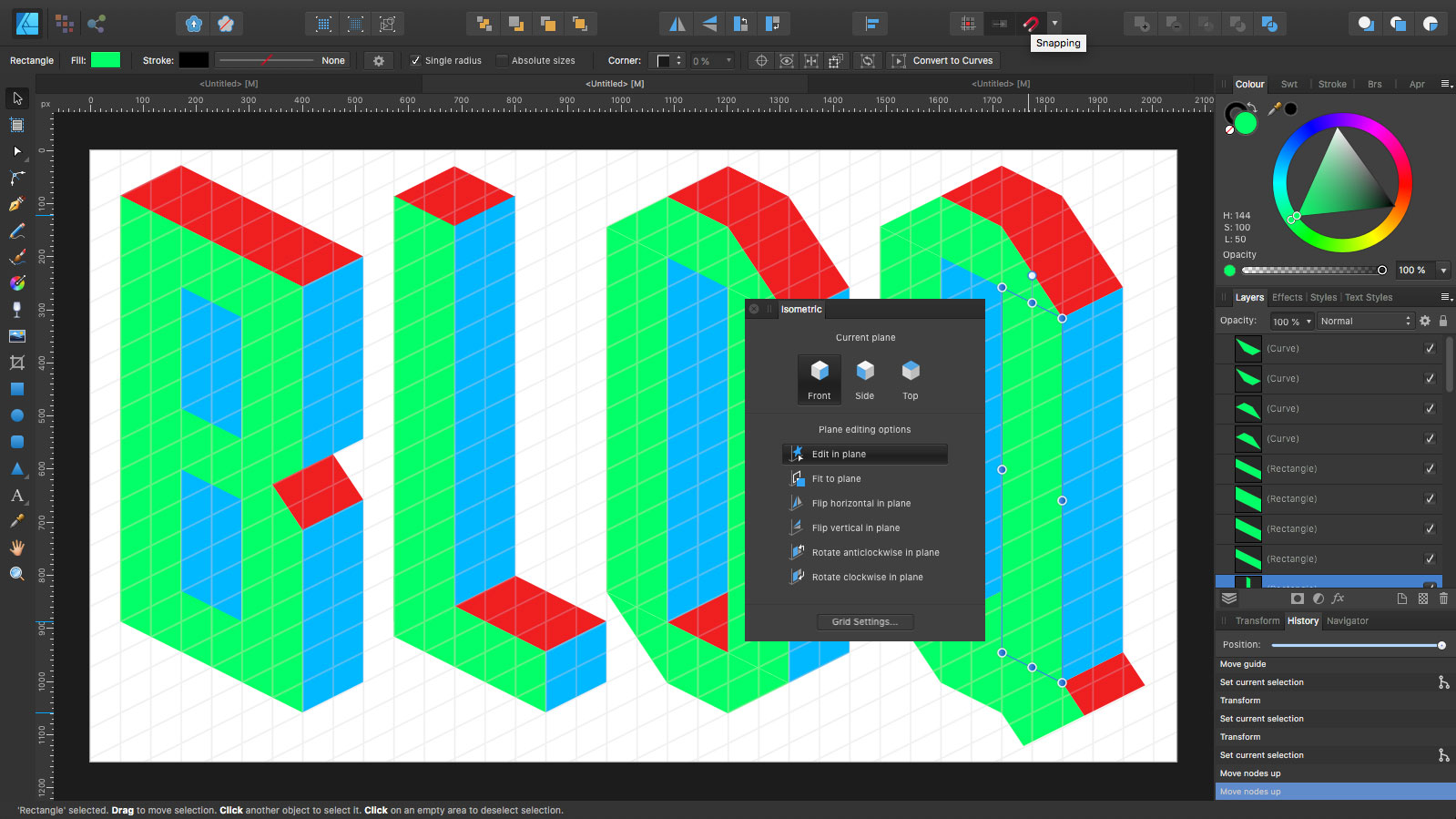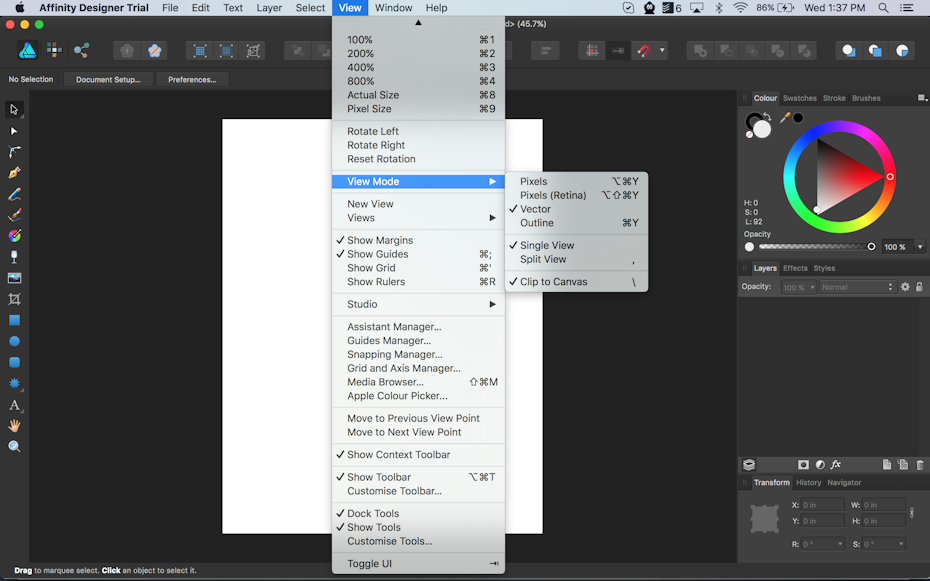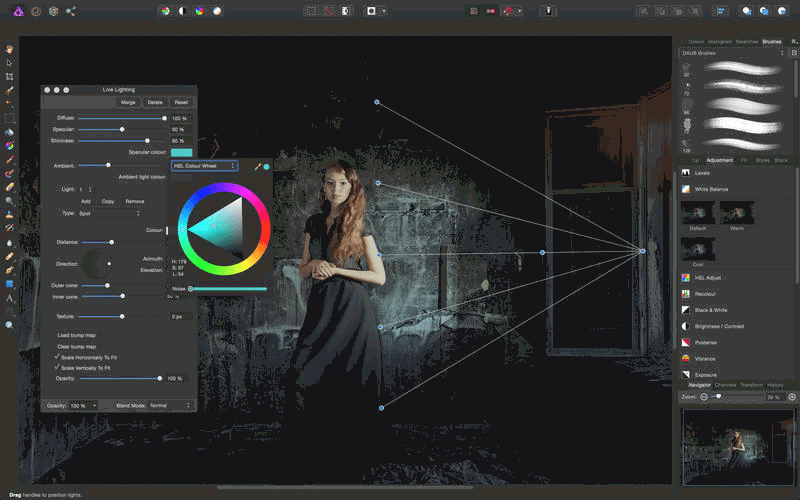Written by Echo Rivera and Jason Rivera
Affinity Designer Pricing Overview Affinity Designer pricing starts at $24.21 per feature, as a one-time payment. They do not have a free version. Affinity Designer does not offer a free trial. Affinity Designer. Full price was $49.99 $49.99 Now $24.99 $24.99. Save $25.00 Affinity Publisher. Full price was $49.99 $49.99 Now $24.99 $24.99. Affinity Designer is a vector graphic design solution used by professional designers, artists, and creatives who are working on illustrations, icons, branding, UI designs, typography, print projects, mock ups, web graphics, pattern designs, and concept arts. Reasons for Switching to Affinity Designer: Cost. Adobe = $20 dlls/Month vs Affinity Design = $25 dlls unique payment. Features are very similar, locally installed and run (faster). To me, the Affinity suite is what Adobe Suite (Illustrator, Photoshop, InDesign) was many years ago, before Adobe grew too big.
So you’re an academic, researcher, scientist, or evaluator interested in learning how to create your own visuals and you’re wondering what application to use?
Chances are you already know about Adobe Illustrator, and maybe you’ve even heard of Inkscape. But have you heard about Affinity Designer?
I mean…we’ve only been talking about it for the last few blog posts 🤣, starting with this one about why you should learn how to make your own visuals. And then there’s this post which shows examples of how researchers, academics, and researchers could use it in their work.
So maybe the real question you’re wondering is: Why do we talk so much about Affinity Designer and not Adobe Illustrator?
We ditched Adobe Illustrator for Affinity Designer and are thrilled with this decision. In this blog post, we’ll provide the 4 reasons that we love Affinity Designer and not Adobe Illustrator.
Adobe Illustrator used to be something you could pay for upfront and then use it for years and years.
LOL not anymore! Sorry, suckers, you’ll now need to pay EVERY SINGLE MONTH FOR ALL OF ETERNITY 💸💸💸, even if you don’t use any of the new features they add or if they remove features you already use.
So, if you want to start learning how to make your own illustrations, and you choose Adobe Illustrator, you could be locked into paying $31.50 EVERY month…FOREVER 💸💸💸. Well, no … actually not forever because they’ll raise their prices so it’ll be even more than that over time.
In contrast, Affinity Designer (cue angelic choir song 🙌) charges a ONE TIME fee for their product. Plus you get free updates (which includes bug and feature updates).
Just in case you think subscription is better for something like Affinity Designer and Adobe Illustrator, you probably won’t benefit from a subscription model because you’re not a graphic design professional. You only need these to do things like make visuals for your PowerPoint or Keynote presentations, visual abstracts, or other materials related to your research or teaching.
Let’s do the maths: in TWO months, you’ve already saved money by choosing Affinity Designer over Adobe Illustrator. Plus if you take our Affinity Designer course, you get 20% off Affinity apps, so you can save even more money. #JustSayin
How much could you save in 1 year by choosing Affinity over Adobe?
COST OF ADOBE ILLUSTRATOR AFTER 12 MOS: $378 Flash 9.0 download mac.
COST OF FULL-PRICE AFFINITY DESIGNER AFTER 12 MOS: $50
SAVINGS AFTER 1 YEAR = $328 ($338 for our online course students)
How much could you save in 2 years by choosing Affinity over Adobe?
COST OF ADOBE ILLUSTRATOR AFTER 24 MOS: $756+
Download software for scanner for hp m1212nf for mac. COST OF FULL-PRICE AFFINITY DESIGNER AFTER 24 MOS: $50
SAVINGS AFTER 2 YEARS = $706+ ($716+ for our online course students)
Yes, you do need to buy a license for each type of operating system, but even if you have to buy every version of Affinity Designer (Windows, Mac, iPad), you don’t have to endlessly pay a subscription fee, so you will still come out ahead.
Maybe you think Affinity Designer is cheaper because it comes with less features?
Nope.
We check in with the Illustrator updates just to see if we’re missing anything that Affinity Designer doesn’t have and have never felt like we were missing out. To us, it’s not worth the monthly price and we actually do graphic design work(e.g., comics, custom illustrations and visuals) for academics, researchers, evaluators, and scientists. If we don’t feel the need to have it, then you—someone who will probably use it mostly for your own work—probably won’t either.
We use Affinity Designer almost every day for things like infographics, web graphics, social media graphics, theoretical models, and more. It has everything we need. Plus, just like Illustrator, you can add things like brushes, fonts, textures, etc. to Affinity Designer if you ever want to make more advanced images.
Affinity has done things like make a full-featured version of their software for the iPad before Adobe did. So a smaller company like Affinity is just as able to innovate and include features as the big, industry-dominating one.
Maybe you think Affinity Designer is cheaper because it’s harder to use?
Nope.
We totally get why you might be worried about this. Have you ever tried using Inkscape? It’s a free, open-source alternative to Adobe Illustrator. When we went looking for Illustrator alternatives, we started there. Jason, who hadn’t used Illustrator very much, found it kinda annoying but okay. Echo, who had used Illustrator for a few years, had a really difficult time figuring it out. Especially after coming from something so easy to use, Inkscape was a frustrating nightmare.
So, we were both skeptical that Affinity Designer would be much better. We’ve never been more happy to be proven wrong.

If you’re worried about the learning curve for digital illustration software, then you’ll be pleased to know that we both find Affinity Designer significantly easier to use than Adobe Illustrator (and a million times easier than Inkscape). Compared to Illustrator, Affinity Designer has a much more user friendly setup that will be easy for beginners to learn.
And get this: If you’ve used Adobe Illustrator in the past, there will be very little learning curve and adjustment for you. Echo used Adobe Illustrator for something like 3-4 years before switching to Affinity Designer, and was able to pick up almost everything in Affinity without even looking up how to do it. And yes, Affinity Designer can open .ai files (and .eps files, obvi) just fine.
Affinity is great because they aren’t overcharging for their software or trying to lock you into a never-ending subscription. They are also great because they don’t do things that Adobe does which we find…disagreeable.

Adobe has done things like “testing” higher pricing for customers even though they didn’t officially raise the price of their subscriptions, so some new customers paid a higher price than they had to. They’ve also tried to scare customers that still use their older, non-subscription software into thinking they could have legal trouble if they keep using their old software. Adobe has also been known to try to make it difficult and annoying to cancel your subscription, kind of like cable companies.

Affinity Designer Cost

Affinity Drawing Software
Given these actions you would think Adobe is strapped for cash and selling their products at a loss, but no. These actions are coming from a company that made about $2.5 billion in profit in 2018. And a great way for them to make more money is to just keep increasing their subscription prices without a corresponding increase in features. A quick internet search will lead you to plenty more critiques of Adobe’s business model and practices. (See also: Additional Reading below)
(No, Affinity hasn’t paid us a dime or given me a free license. After a year of publicly telling everyone how much we love Affinity Designer, we were finally able to secure a discount on their apps for our Affinity Course students. We don’t make any money off that, the savings are passed directly onto you. We really just love this program and think it’s a perfect fit for academics, scientists, evaluators, researchers, and educators).
Affinity Designer Cost
Additional Reading:
